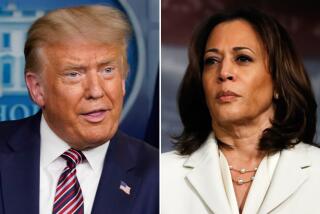Staples Incident Rocks Times, Inside and Out
- Share via
Credibility. Integrity. Those bulwarks of journalism are qualities that readers expect to define the Los Angeles Times. But some are questioning The Times’ adherence to those values in light of disclosures that revenue from the Oct. 10 Los Angeles Times Magazine were shared with Staples Center, the sole subject of that issue.
The profit-sharing arrangement, denounced by Times journalists as well as many readers, was not known to the magazine’s writers and editors who produced the issue, and they were the most profoundly distressed to learn of the deal.
The magazine was overseen by four editors known for strong professional ethics--Magazine Editor Alice Short, Sports Editor Bill Dwyre and his deputy, Rick Jaffe, and John P. Lindsay, managing editor for features and design. The magazine’s editorial content was free of influence from The Times’ advertising department or from Staples. But the appearance of conflict was present, which is why the incident is so deeply disturbing.
The profit-sharing arrangement was part of The Times’ agreement as a founding sponsor of the arena, a partnership that should have called for extra caution so coverage could not be seen as influenced by business considerations. Some readers suggested that the partnership was responsible for the extensive coverage of the center in The Times, and one asked: “Was this [magazine] an effort to boost the paper’s own financial investment in the new arena?”
The appearance of conflict was reason enough for Short and Lindsay to object to devoting an entire issue of the magazine to the opening of Staples Center. They preferred that the newspaper publish an “advertorial” section--one written and produced by Staples itself or by The Times’ advertising department and clearly labeled “advertising supplement.”
But Editor Michael Parks, who believed that the opening of Staples was a major event for downtown Los Angeles and who has said he was unaware of the profit-sharing agreement, decided that Staples coverage planned by the sports department and a special section proposed by the advertising department would best be joined into one editorial publication--an issue of the magazine. That was a huge mistake. Parks, a respected Pulitzer Prize-winning journalist, felt confident that the magazine reporting would be honest, and it was. But mixing the paper’s journalism with its business interests has the potential for corruption and undermines readers’ trust.
One reader, reflecting the opinions of many, said: “Integrity in The Times’ reporting is essential to trusting The Times as a news source. Once that trust is compromised, as it now is, one cannot help questioning the integrity of all of its news stories and columns.” Another said: “Confidence in the paper’s integrity among the general public, the employees of The Times and their peers has been lost.”
Such comments devastate Times journalists, who strive to abide by practices that ensure journalistic integrity and independence. Most reporters and editors border on the religious in their zeal to avoid conflicts of interest and even the appearance of them. Some political writers register to vote as independents so they cannot be accused of political bias. Reporters won’t accept free tickets to events or have meals paid by sources and, in most cases, won’t accept paid speaking engagements. Most won’t have stickers on their car bumpers promoting a cause.
Readers and journalists say the Staples incident gives ammunition to cynics who believe that journalists promote their own or the newspaper’s positions on issues or is “for sale.” One reporter said he was interviewing a political consultant last week who joked: “What’s the going rate to get my guy on Page 1?” Times journalists are not finding this sort of humor funny.
The Staples incident confirms their worst fears from 1997, when Mark H. Willes, who was then publisher as well as chairman and chief executive of the newspaper’s corporate parent, Times Mirror Co., declared that he wanted to bring down the traditional “wall” between advertising and editorial and establish closer ties between those two sides of the newspaper.
Cooperation appeared to work well at first--the Monday Health section, popular with readers, was conceived and developed through such advertising-editorial teamwork; since its launch, the two sides work independently. But the Staples incident illustrates the dangers and reaffirms why reporters and editors believe that wall is crucial to journalistic integrity.
One longtime reader, who has “loved The Times since I was a small boy in the ‘50s,” reflected the disappointment of many readers when now, for the first time, he felt compelled to question “The Times’ journalistic integrity anywhere in the paper.” He enjoys auto reviews but now wonders: “How critical of an auto maker can the reporters be if The Times may be getting a payback from the same auto maker?” That’s not true, but just the fact that he raises a question about its being possible is profoundly disheartening.
In a meeting 10 days ago with angry journalists--reported in The Times the next day--Publisher Kathryn M. Downing apologized for her lapse in judgment in approving the Staples profit-sharing arrangement, and she reaffirmed that advertising would never be allowed to influence editorial.
Downing asked editors to draft guidelines to ensure editorial independence. Also, Parks has asked Times Pulitzer-Prize winning reporter David Shaw to thoroughly investigate the Staples Center controversy and report his findings in The Times.
Editorial independence to pursue the truth wherever it leads, even, if necessary, to the discomfort of the newspaper’s advertisers or owners, is vital to a free press.
*
Narda Zacchino is Times’ associate editor and readers’ representative. She can be reached at (877) 554-4000; fax: (213) 237-3535; e-mail: readers.rep@latimes.com; mail: Times Mirror Square, L.A. 90053.
More to Read
The biggest entertainment stories
Get our big stories about Hollywood, film, television, music, arts, culture and more right in your inbox as soon as they publish.
You may occasionally receive promotional content from the Los Angeles Times.










